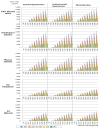Comparison of Fluid Flow Rates by Fluid Height and Catheter Size in Normal and Hypertensive Blood-Pressure Scenarios
- PMID: 39685067
- PMCID: PMC11641750
- DOI: 10.3390/healthcare12232445
Comparison of Fluid Flow Rates by Fluid Height and Catheter Size in Normal and Hypertensive Blood-Pressure Scenarios
Abstract
Objectives: This study is performed to determine the effects of fluid height, inner catheter diameter, and peripheral venous pressure on room-temperature intravenous fluid administration.
Methods: We employed the Bernoulli equation, with frictional forces considered for volumetric analysis.
Results: The results of this study demonstrate that infusion-set height, catheter size, fluid type, and blood pressure significantly affect flow rates. Under normotensive conditions, flow rates ranged from 58.2 to 10,743.18 cc/h, with the highest rates observed at a 1 m infusion-set height and larger catheters. Additionally, 6% hetastarch exhibited the lowest flow rates, while 0.9% normal saline showed the highest. Under hypertensive conditions, slightly higher infusion-set elevations were required for measurable flow rates, but they remained lower than those under normotensive conditions.
Conclusion: This study investigates the mechanics of peripheral venous fluid therapy and provides foundational data for future nursing research on fluid management.
Keywords: flow rate; fluid dynamics; fluid therapy; infusion system; peripheral intravenous catheter.
Conflict of interest statement
The authors declare no conflicts of interest.
Figures


Similar articles
-
Control Volume Analysis of the Infusion Rate in Cephalic and Median Cubital Veins Based on Infusion Bag Height and Peripheral Venous Catheter Inner Diameter: Application of Bernoulli's Equation and Consideration of Frictional Forces.J Multidiscip Healthc. 2023 Nov 24;16:3609-3618. doi: 10.2147/JMDH.S409050. eCollection 2023. J Multidiscip Healthc. 2023. PMID: 38034878 Free PMC article.
-
Analysis of flow rate of continuous bladder irrigation according to the height of the irrigation infusion set.Sci Rep. 2023 Nov 12;13(1):19715. doi: 10.1038/s41598-023-47198-2. Sci Rep. 2023. PMID: 37953276 Free PMC article.
-
A pressure-resistant peripherally inserted central catheter is as useful as a central venous catheter for rapid fluid infusion: an in vitro study.BMC Anesthesiol. 2022 Jul 4;22(1):205. doi: 10.1186/s12871-022-01738-x. BMC Anesthesiol. 2022. PMID: 35787789 Free PMC article.
-
Medication and volume delivery by gravity-driven micro-drip intravenous infusion: potential variations during "wide-open" flow.Anesth Analg. 2013 Mar;116(3):614-8. doi: 10.1213/ANE.0b013e31827bc235. Epub 2013 Feb 11. Anesth Analg. 2013. PMID: 23400996
-
Flow rate accuracy of infusion devices within healthcare settings: a systematic review.Ther Adv Drug Saf. 2023 Jul 21;14:20420986231188602. doi: 10.1177/20420986231188602. eCollection 2023. Ther Adv Drug Saf. 2023. PMID: 37492690 Free PMC article. Review.
Cited by
-
3D-printed temperature and shear stress-controlled rocker platform for enhanced biofilm incubation.Sci Rep. 2025 Jun 4;15(1):19575. doi: 10.1038/s41598-025-04575-3. Sci Rep. 2025. PMID: 40467684 Free PMC article.
References
-
- Westbrook J.I., Duffield C., Li L., Creswick N.J. How much time do nurses have for patients? A longitudinal study quantifying hospital nurses’ patterns of task time distribution and interactions with health professionals. BMC Health Serv. Res. 2011;11:319. doi: 10.1186/1472-6963-11-319. - DOI - PMC - PubMed
-
- Kim J.I., Lee J., Chang O. Perceived importance and performance of intravenous fluid therapy by nurses in small-medium general hospitals. J. Korean Acad. Fundam. Nurs. 2013;20:372–380. doi: 10.7739/jkafn.2013.20.4.372. - DOI
LinkOut - more resources
Full Text Sources

